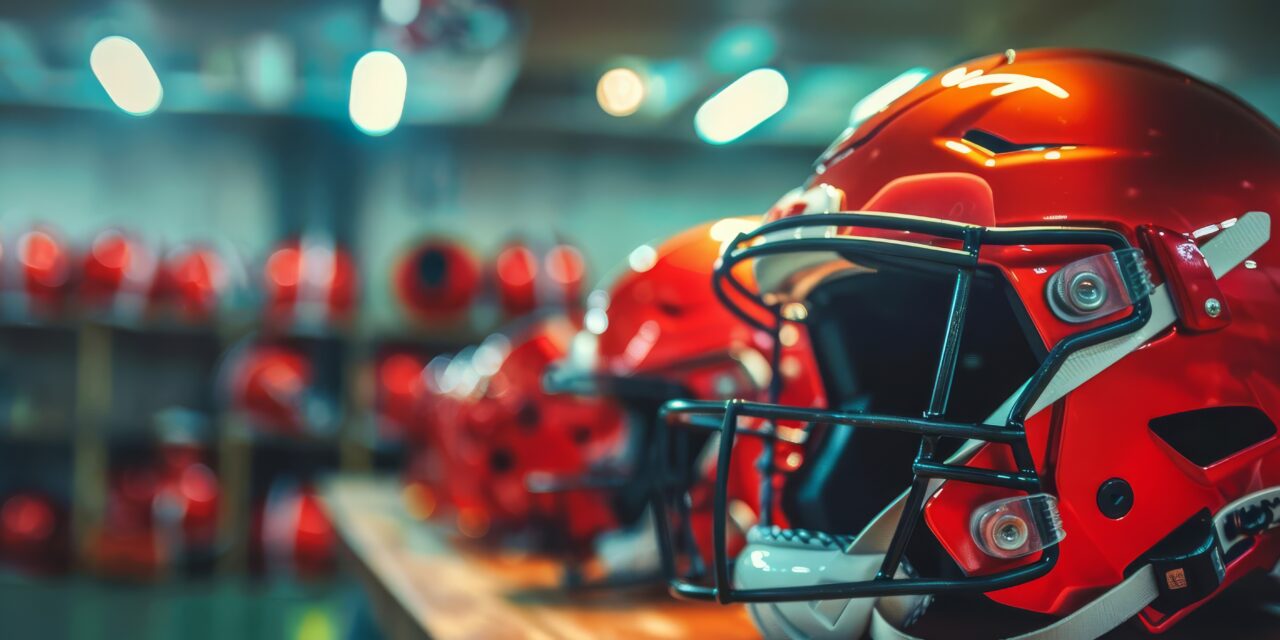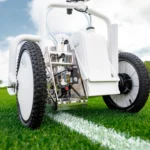Equipment storage may be the last thing on your mind as the fall sports season enters full swing, but thinking ahead about how to safely clean, store, and maintain equipment removes any complications that may occur later on. Make sure to take the following factors into account as you prepare for the end of the football season.
Organizing Equipment
Before storing anything, it’s important to take stock of what you have. Creating an inventory of all football equipment, including helmets, pads, uniforms, training tools, and other gear, helps with staying organized. By tracking the condition of each item, you can easily identify what needs to be repaired or replaced, and assist in planning for the next season.
- Helmets: Check the shell for cracks or dents and inspect padding for signs of compression or wear. Ensure that all fasteners and chin straps are secure and functional. Check the age and condition of each helmet and determine if reconditioning is necessary.
- Shoulder Pads: Look for cracks, tears, or broken buckles. Pay attention to the foam padding inside for signs of thinning or brittleness, which can reduce protection.
- Cleats: Inspect soles for excessive wear and check that the cleats are intact and securely attached.
- Uniforms: Look for any tears, fraying, or weakening of fabric, especially in high-stress areas like shoulders and knees.
Many athletic directors find success using digital inventory systems to streamline the organization process. These systems help categorize and label items, making future retrieval simple and efficient. Digitizing your inventory can also ensure that you’re well-prepared when it’s time to reorder or check off equipment as it’s used again.
Cleaning and Sanitizing Equipment
It’s critical to thoroughly clean all football gear before storage. Helmets, pads, and uniforms are regularly exposed to sweat, dirt, and bacteria, which can damage the materials if left uncleaned. By cleaning everything before storing it, the risk of mildew, odors, and deterioration is reduced.
Specialized cleaning solutions for helmets and pads ensure deep sanitization without harming the equipment. For uniforms, follow manufacturer recommendations on laundering to maintain fabric integrity.
- Helmets and Pads
Use a mild soap solution or a disinfectant spray specifically designed for sports equipment. Ensure the cleaner is non-corrosive and safe for plastics and foam padding to avoid degrading the materials. For hard shells (helmets and exterior pads), wipe them down with a soft cloth and the soap or disinfectant solution. For internal padding, remove any detachable parts and either hand-wash or machine-wash them, depending on the manufacturer’s recommendations. - Uniforms
Wash uniforms according to their care labels. Use mild detergent to maintain the color and fabric integrity. Adding a sanitizing agent or oxygen bleach can help kill bacteria and remove tough stains, especially in areas like armpits and knees. Air dry uniforms or use a low-heat setting to avoid shrinking or weakening the fabric. - Cleats and Gloves
For cleats, brush off dirt and debris, and use a damp cloth with a mild soap solution to clean the exteriors. Allow them to dry fully before storing to prevent mold. Gloves, especially if they are leather, should be cleaned with a damp cloth and a leather-safe cleaner, then air-dried.
Drying Procedures
Before putting any equipment into storage, it’s vital to ensure everything is completely dry. Storing damp gear, especially items with fabric or foam padding, can lead to mildew, bacteria growth, and material breakdown. Here are some drying best practices:
- Helmets and Pads: After cleaning, let helmets and pads air dry in a well-ventilated space. You can place them in front of fans or use specialized sports gear drying racks. Avoid using high heat as it may warp plastic or degrade padding materials.
- Uniforms and Gloves: Air drying is preferred, but if time is a concern, a low-heat dryer can be used for uniforms. Hang gloves in a dry, shaded area to avoid direct sunlight, which can dry out and crack the material, especially leather.
Consider using a dehumidifier in the drying room to speed up the process and ensure no residual moisture remains.
Storage Solutions
Once everything is inspected, cleaned, and dried, it’s time to store the equipment properly to ensure it stays in good condition. Choosing the right storage method is crucial for maintaining the quality of your football equipment. Invest in climate-controlled storage to prevent extreme temperatures from damaging sensitive materials like leather, foam padding, or plastic. For items like helmets and shoulder pads, it’s best to use racks or shelves to maintain their shape and avoid unnecessary pressure on them.
- Climate-Controlled Storage: Football equipment should be stored in a dry, climate-controlled environment. Extreme temperatures and humidity can warp plastics and degrade padding over time. Avoid damp basements or non-ventilated areas where moisture could build up.
- Helmet and Pad Storage: Use racks or shelves to store helmets and pads, ensuring they maintain their shape and don’t have pressure points that could cause warping. Hanging pads or using shelves with adjustable dividers will prevent compression.
- Uniform Storage: Hang uniforms on racks or use breathable garment bags to protect them from dust. Avoid using plastic storage containers for fabric as they can trap moisture and lead to mildew.
- Cleats and Gloves: Store cleats in individual cubbies or on racks, ensuring they are completely dry. Gloves should be stored flat or hanging to maintain their shape.
Organized storage containers with labels make it easier to find specific equipment when needed. Label storage bins and shelves clearly, group like items together (e.g., all helmets on one rack, all shoulder pads on another) to streamline retrieval and avoid misplacement.
Maintenance and Replacements
It’s tempting to forget about the equipment once it’s safely stored, but regular maintenance checks throughout the off-season are essential to ensure everything remains in top shape. Schedule a quarterly inspection to look for signs of deterioration, rust, or damage that could occur while in storage. Addressing minor repairs now can prevent bigger issues later.
These checks give you ample time to repair or replace any gear well before the next season begins, avoiding last-minute scrambles. Encourage your coaching staff to participate in these maintenance checks, as their insight into how often gear is used can highlight what might need attention sooner.
Storage time is the perfect opportunity to assess which items will need to be replaced, repaired or reconditioned before the next season. Create a timeline for submitting purchase orders or scheduling repairs so that you have everything ready well in advance of the first practice. Working ahead also allows you to take advantage of off-season deals, and ensures all necessary equipment is ready before training resumes.
Storing football equipment properly after the season not only extends the life of your assets but also ensures player safety and helps keep your athletic department running smoothly. By following best practices for cleaning, drying, inspecting, and storing, athletic directors can ensure their football programs are well-prepared for the next season.










